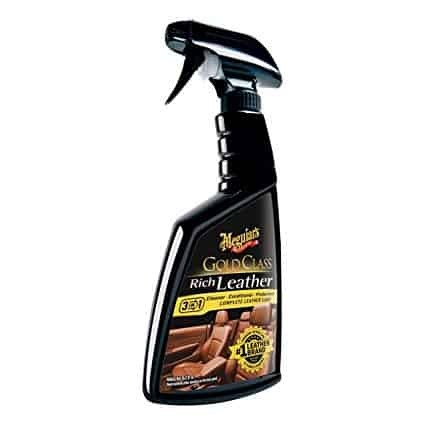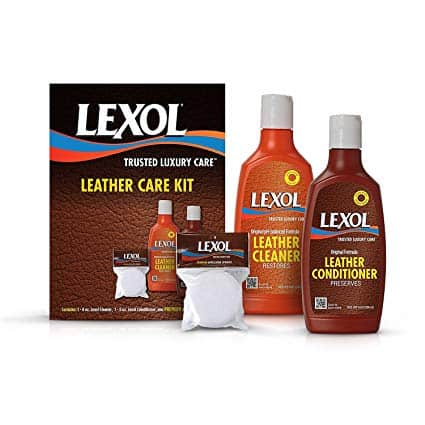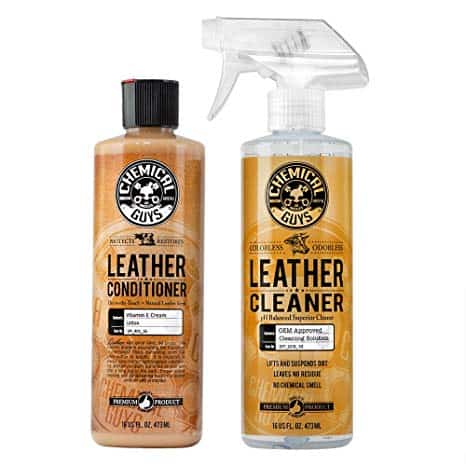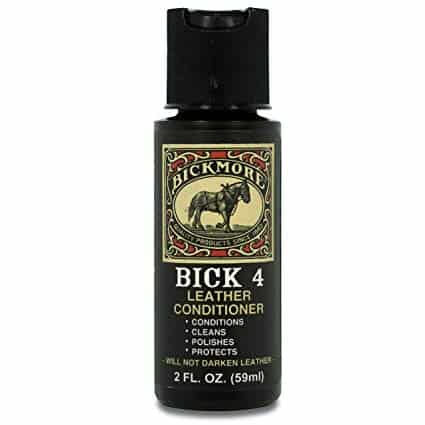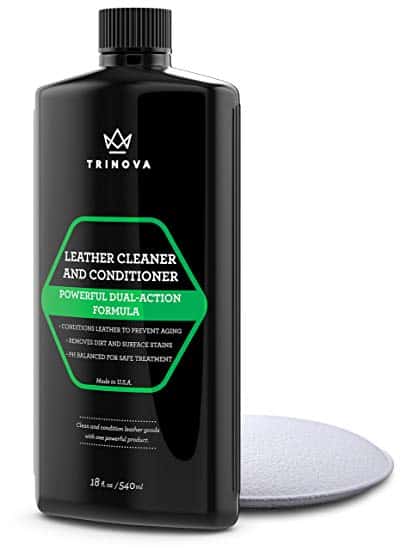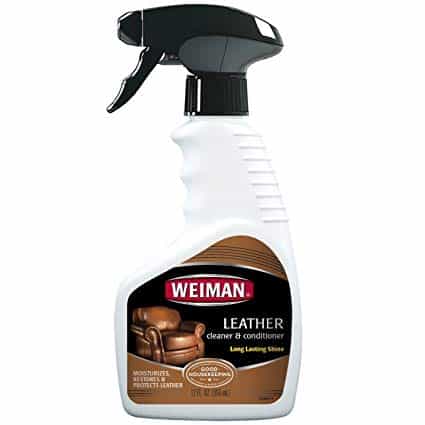There is a reason that high-end and luxury vehicles include a leather interior and a recommend car leather cleaner for tidying said interiors. Leather makes for a better car interior. Whether synthetic or genuine, it is hands down more aesthetically pleasing and more luxurious than any other materials in vehicle interiors.
A leather interior adds to your vehicle’s resale price, so there is no question whether it is worth the extra money upfront. A pristine and well-taken-care-of leather interior is hard to beat, but a worn-in, cracked, and faded leather interior is worse than not having leather in the first place.
Leather, for all its aesthetic and luxurious charms, is highly susceptible to sun damage and regular wear and tear. Neglecting your car’s leather interior can quickly become an expensive oversight should you ever wish to sell your vehicle. Over time, leather seats begin to crack, tear and fade as regular use and exposure to damaging ultraviolet light eats away at the protective factory coatings and conditioners. Dust and grime cling to the small pores that cover the leather surface and make it look blotchy and stained, not to mention the greasy odors and stains caused by sticky fast foods and other automotive fluids.
Luckily there are a number of products available that can restore your drab, cracked leather interior back to its factory luster, and protect it from further unsightly damage.
10 Best Car Leather Cleaners
There are as many car leather cleaners on the market as there are leather car interiors. Some are incredibly powerful but too harsh for use on the finer leathers, while others lack the cleaning power required for automotive stains.
The 10 car leather cleaners collected here are the best of 2020 because they combine the features of a powerful automotive cleaner with the gentle, protective conditioning of delicate household cleaning solutions.
What is Car Leather Cleaner?
Car leather cleaner generally consists of a chemical cleaning agent that is specially designed to remove dirt and oil from the surface of leather vehicle interiors. Manufactured by household and automotive product companies, leather cleaners come in a wide range of variations, uses, and chemical combinations.
Many multi-purpose car cleaning products will work on leather interiors, but cleaners explicitly designed for leather seats are safer to use and many times provide much better and lasting results.
There are hundreds of different leather interior designs and materials out there. Before applying any cleaner to your car leather, it is essential that you thoroughly read the application instructions to ensure the cleaner will not damage the specific leather surfaces that are in your vehicle.
Car Leather Types
What many car owners don’t know is that there are four different types of leather used in car interiors, all of which are different to the touch, produce a different aesthetic, and require specific care.
Most car dealers will disclose which type of leather was used in the vehicle during the sale process. However, not all cars are bought from a dealership, which is why it’s important for every potential car buyer to be able to identify and differentiate between the different types of leathers used in car interiors.
Aniline Leather
If you drive a vehicle with aniline leather then it’s a good idea for you to pay attention because only rarely, if ever, do affordable non-luxury vehicles include aniline leather interiors.
Aniline leather is considered by most to be the best leather used in car interiors. Aniline leather is made from the highest-quality- animal hides available and used almost exclusively in luxury vehicles. It gets its name from the aniline dyes used to create the vibrant colors used in British luxury vehicles and Italian sports cars.
Aniline leather ranks at the top of the scale when it comes to quality, but as such it is also the car leather type that is the most susceptible to wear and tear due to a lack of any protective factory coatings.
Cars with aniline leather interiors require regular cleaning and conditioning to avoid fading, damage, and a substantially more expensive professional leather repair. Luckily, unless you drive a Rolls Royce or a Ferrari, your car probably does not include aniline leather.
Semi-Aniline Leather
Aniline leather that has been treated with a protective coating and conditioners are referred to as semi-aniline. These coatings make the color of the leather more uniform, and the natural pattern of the leather hide less apparent. Semi-aniline leather is generally found in higher-end vehicles like Porsche and Mercedes.
Though semi-aniline leather car interiors are coated with chemical protectors to be more resilient, they are still susceptible to spills and damage, which is why it is still important to regularly clean and maintain it.
Full-Grain Leather
The most commonly recognized full-grain leather used in car interiors is Nappa Leather.
Full-Grain leather is texture treated to retain the natural pattern of the leather hide and conditioned to be more durable than aniline and semi-aniline leather. It is generally more durable and less susceptible to damage than aniline leather, but due to the extra chemical treatments, it is considered a step below aniline leathers when it comes to quality.
Corrected-Grain Leather
Corrected-Grain leathers are the most conditioned and chemically treated leathers available on the automotive market and are therefore the most durable and affordable.
Auto manufacturers have dyed and treated corrected-grain leathers into nearly every color imaginable since they started using leather in car interiors. That is because corrected-grain leather is not made from the highest-quality hides, but are instead buffed and corrected in the manufacturing process. Corrected-grain leather interiors are very common and generally included in more basic leather packages.
How to Use a Car Leather Cleaner?
Oils from your skin, dirt, ultraviolet light, and regular wear and tear can fade leather seats in no time. Even if your car’s leather seats and interior looks spotless and in excellent condition, it is still a smart idea to regularly clean and protect your car’s leather.
Buying the right product is a good place to start, and now that you know about the different types of leathers used in car upholstery you’ll be able to purchase a leather cleaner that won’t damage your car’s leather interior.
The next step in the car leather cleaning process is breaking out the tools that you’re going to need to get the job done. You’ll need:
- Vacuum (handheld will do)
- Vinegar
- Water
- Bucket
- Microfiber towel
- Soft sponge
- Leather Cleaner
Now that you have your tools it’s time to get to work cleaning your car’s leather.
Prep The Leather Surface
Before you apply any cleaner to your leather it is critical that you remove excess dust and debris from the leather surface. Applying leather cleaner to leather that is covered in dust and dirt can permanently scratch the surface. It’s always a good idea to vacuum your car’s leather (especially the seats) prior to applying any sort of car leather cleaner or cleaning solution.
Once you have removed the loose dirt and detritus from your car leather, it is time to clean the leather surface. Mix one part vinegar and two parts water in your bucket to create a leather-safe cleaning solution. Wet your soft sponge in the solution and thoroughly clean the car leather in need of treatment. Be sure to quickly wipe away the solution after application. Do not let any solution dry on your car leather. Doing so allows all the dirt you just scrubbed off the settle back into the leather surface.
Apply The Car Leather Cleaner
Here is where the car leather cleaner you purchased is finally utilized. Apply the leather cleaner per the manufacturer’s instructions. Some leather cleaners can be conveniently sprayed onto the leather surface while others need to be applied with a microfiber rag or application tool.
Once the leather cleaner has been applied per the manufacturer’s instructions, it’s time to remove it with a microfiber towel. Again, do not allow any cleaning solution to dry on your car’s leather.
Enjoy Your Vehicle’s Leather Interior
The last step is to sit back in your freshly-cleaned leather seats and try not to spill anything on them. However, if you’re anything like the rest of us, your car leather will undoubtedly require another cleaning down the road.
Luckily, now you know how to identify and clean your car leather as well as a professional detailer, so you shouldn’t settle for just any old leather cleaner for the interior of your car. Not all car leather is created equal, and neither are the car leather products meant to clean them. Your vehicle deserves a car leather cleaner that is up to par with your newly acquired leather cleaning skills.
Your car is an investment, and a neglected leather interior can ruin your investment in the same sense that electrical issues or hail damage might. Purchasing any one of these car leather cleaners is a good investment. Just remember that, unless you plan on never driving your car in the sun, your car leather will require a regular application, maintenance, and restoration to stay factory beautiful. Luckily, the car leather cleaners featured here are the best of 2020 and have proven their worth as powerful cleaners, conditioners, and protectors, and can be trusted to keep your car looking fresh and presentable.
Frequently Asked Questions
Can I condition my leather seats without leather cleaner?
While you can condition leather without cleaning first, it is not recommended. A conditioner will make leather feel softer and more supple, but can trap dirt and dust into the leather if the surface isn’t cleaned first.
To prevent leather from aging and breaking down prematurely, thoroughly clean the leather before treating with a conditioner.
Is rubbing alcohol safe on car leather?
If you need to remove a pesky spot stain, for something like pen ink, then rubbing alcohol can be effective. Use a cotton swab dipped in rubbing alcohol to spot treat stained leather.
Be sure to test it on an out of the way spot, to ensure that the alcohol has no adverse reaction to the specific leather you’re treating. Alcohol can dry out and crack leather, so be sure to only use it for hard to clean spot stains. Always be sure to rub off any excess fluid, let dry completely, and protect the leather once cleaned with a leather conditioner.
Can Lysol wipes be used on leather car seats?
Lysol and other disposable cleaning wipes many times contain alcohol. Alcohol can dry out and damage your car’s leather interior. Do not use any wipes with alcohol on your car’s leather.
Is olive oil and/or coconut oil good for your vehicle's leather interior?
No, oily substances are not good for your car’s leather interior. Some say these oils will help nourish your leather, but in reality, they will clog the pores in the leather and speed up the leather’s degradation. Leather is permeable, and this is why you need to use a good leather cleaner to lift and remove oils and dirt. Do not add oils to the leather on purpose.


